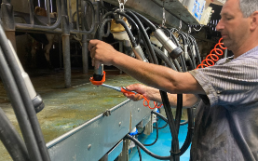Passionate about Tradition and Innovation
Our second trip takes us Oberegg, to Hans and Johannes Eberle’s cheese dairy. Their respect for tradition and passion for innovation is truly inspiring.
Our second trip takes us Oberegg, to Hans and Johannes Eberle’s cheese dairy. Their respect for tradition and passion for innovation is truly inspiring.

Night watchmen were on the payroll of the baroque old town of Bischofszell until 1940. In remembrance of this tradition, the Bischofzell Guild of Night Watchmen and Tower Watchmen was founded in 2004 with over 30 night- and tower watchmen from all over Europe in attendance. The Guild remains active to this day, offering e.g. its popular Night Watchman tours. The founding of the Guild inspired Hans to launch his unique Nachtwächter cheese in 2006, to great success.

In 1980, Hans’s father, who ran the Oberegg cheese dairy, switched from the production of Emmentaler to Appenzeller cheese. Hans took over the dairy in 1987 and contributed in no small measure to the Appenzeller success story. Success brought increasingly vocal demands from the dairy’s market partners to ensure maximum quality and consistency of the cheese. This led to the increased importance of milk thermisation, and the Appenzeller cheese went from being a cheese from raw milk to a cheese with raw milk.
In 2006, Hans developed the Nachtwächter cheese with the twin aims of continuing to preserve as much of the traditional craft as possible and launching a new type of cheese that clearly differed from Appenzeller.
In 2010, Hans took over the cheese dairy in the neighbouring village of Muolen, since which time the Oberegg dairy has manufactured Nachtwächter cheese exclusively. In 2018, he handed over the reins of the successful family business to his son Johannes.

In the past, before the advent of rennet extract and commercially available starter cultures, Fettsirten-Magenlab (a natural whey starter culture produced by adding cut-up calf ‘vells’ before incubation) was indispensable for the curdling and fermentation processes. Nowadays, few professionals are experienced in the use of Fettsirten-Magenlab. Hans and Johannes are recognised far and wide as specialists, and use it for Appenzeller and for most types of their cheeses. Naturally, it plays a key role in the manufacture of Nachtwächter cheese.
To make the cheese, immediately after the coagulum (curd) is cut, a cauldronful of whey and curds is removed and heated slightly. A portion of the whey is then filled into a cauldron with cut-up calves’ vells from France (photo), some casol (a mixture of acetic and propionic acid) is added, and the mixture is incubated in the incubator. The rest of the whey is cooled in the cold store. After two hours both mixtures are recombined, inoculated with a raw mixed culture and an ‘eye’-formation culture from ‘Liebefeld Kulturen’ and incubated overnight in the incubator. The following morning the vells and curds should be floating at the top. After stirring and sieving, the acidity of the Fettsirten-Magenlab is measured and the mixture is placed in cold store until use. According to Johannes, a good Fettsirten-Magenlab should have at least 60 degrees of acidity and four times as many “rods” (lactobacilli) as “chains” (streptococci), which is significantly higher than for other starter cultures. These lactobacilli come from the starter cultures, from the raw milk and the vells, and are responsible for the unique flavour and greater degree of maturity of the cheese. The curd plays an important role with the Fettsirten-Magenlab, buffering the lactic acid formed and thus preventing a too-rapid drop in pH and encouraging greater proliferation of the lactobacilli.

The Nachtwächter cheesemaking process is highly conventional up to the point where rennet is added to curdle the milk. From then on, much is done rather differently than expected. The renneted curd is cut into surprisingly small pieces; the rapid acidification and addition of hot water ensure that a fine skin forms on the curd grains so that they dry out less. After a first pressing the cheese is portioned. The cheese mass is still very soft, and the use of the traditional cheesecloths proves highly advantageous here.
While Nachtwächter was being developed, a lively exchange of knowledge and advice took place between Hans and legendary cheese consultant Werner Friedli. Back in the day, Herr Friedli and his colleagues were referred to as ‘cheese dairy inspectors’ and worked for the cantonal dairy inspection and advisory services. “Werner has certainly left his stamp on Nachtwächter” enthuses Hans, with an admiring hat-tip to Friedli.

Before and after the addition of the rennet a sample is taken from the cauldron, filled into test tubes, incubated in the incubator and the acidity of the mixture measured. Until coagulation there are no essential differences between the manufacture of Appenzeller and Nachtwächter cheese, save the fact that only raw milk is used to make Nachtwächter. Interestingly, the acidity levels of Nachtwächter cheese are always somewhat higher than those of Appenzeller, strong evidence of the influence of the raw-milk microbiome on lactic-acid fermentation in the cheese. In the sample taken after the addition of rennet, a little “cheese log” is formed which is thoroughly examined for important indications on the progress of the rennet coagulation, lactic-acid fermentation and syneresis (contraction of the lactoproteins) processes. (Photo)
In these ‘journeys of discovery’, the respective raw-milk products are always brought back to Agroscope Liebefeld for further testing – both for the sensory description and to take samples for analysis at Agroscope. In addition to the chemical and biochemical composition, the microbiome and flavour components are studied. It is a stated aim to publish the results of the analyses in scientific journals, thereby documenting the diversity of raw-milk products. Perhaps we’ll succeed in identifying the lactic-acid bacteria in the raw milk that contribute to fermentation in the Nachtwächter cheese.

The Eberles have very high standards for the microbiological quality of the raw milk. From each farmer, the milk is tested daily by means of a fermentation test and every 2 days additionally with a pre-incubated reductase test.These two samples cover a wide range of undesirable microorganisms, thus ensuring the very high quality and safety of the cheese. These high standards require a considerable additional expenditure of money and effort by the farmers – for example, the teat cups used in the milking parlours are rinsed after each cow (photo), or teats are cleaned before milking with two rather than just one damp cloth. Additionally, the entire milking system is thoroughly cleaned twice daily, alternating an alkaline solution with an acid one. The effort and expense are worth it, given that farmers are paid up to 6.5 centimes more per litre for meeting the high standards. “Sometimes the farmers need a bit of motivation”, Hans says with conviction. It is also important, he feels, for the cheesemaker to be familiar with the specific weak points of the individual farms, in order to be able to provide them with targeted support.

Aus Liebe zum Käse (For the love of cheese) is the motto in the Oberegg and Muolen dairies. It may surprise some that Johannes is the prime mover behind the manufacture of vegan alternatives from lupin. ‘Lupighurt’ has already won its share of fans. They continue to tinker zealously with products to improve quality and expand the range.
The aim is for the raw materials to be produced regionally, unlike many vegan alternatives on the market today. According to Johannes, there are many commonalities between the manufacture of dairy products and their plant-based alternatives: “The technology is comparable, fermentation is key, and the same lactic acid bacteria are needed”. Cheesemakers already have plenty of experience of the high expectations placed on the raw materials, hygiene, quality management and good manufacturing practice. There is also the odd new challenge to be tackled, however, such as undesirable aerobic spore-forming bacteria that may be present on the plant-based raw materials.

A defining characteristic of the Nachtwächter cheese is its black rind – a natural result of its weekly washing with red wine.
At Agroscope Liebefeld we’ve produced sensory descriptions of the «mild» (4 months’ ripening), «mature» (8 months) and ‘extra-mature’ (12 months) Nachtwächter cheeses. All three cheeses have their own unmistakeable character:
All three cheeses boast a long-lasting, multi-faceted and harmonious finish.
On their home page, the Eberles write that Nachtwächter not only goes well with wine but is also excellent with beer and cider. This inspired us to choose eight different sweet and sour ciders from the region for our cheese-and-drink pairings:
Last modification 25.10.2023